Latest Contributions
Read More Contributions
Brigadier Raghubir Singh – Maha Vir Chakra
Category:
Tags:
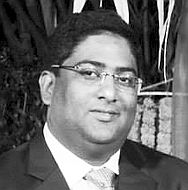
Divij Sharma studied at Mayo College, Ajmer, St. Stephen's College, Delhi, and got his MBA from MICA, Ahmedabad. After working as an Investment Banker with a leading Indian International Bank headquartered in Mumbai, he returned to Jaipur, Rajasthan, his home town. He is now an active part of Rajasthan's oldest daily newspaper, Rashtradoot, which has become the first Hindi-English newspaper in the world. This trend setting initiative has made Rashtradoot the first brand from Rajasthan to be nominated at the prestigious ABBY Award 2016. Also, Rashtradoot was also the only Newspaper to be a finalist in the category "Brand Innovation" from North India for this endeavour.
Editor's note: The Maha Vir Chakra is the second highest military decoration in India, after the Param Vir Chakra, and is awarded for acts of conspicuous gallantry in the presence of the enemy.
This is an adapted version of a story that appeared in Rashtradoot, a Rajasthan newspaper, and is reproduced with permission. The story has been facilitated by Sangram Singh, son of Raghubir Singh, and Subhash Mathur, both of whom were students of St. Xavier's school, Jaipur.
We welcome additional materials about Brigadier Singh - pre-Army, in-Army, and post-Army times - from relatives, friends, colleagues and other people who know him. We also welcome similar materials - for their own stories - about other heroes and martyrs of the Indian Armed Forces, provided the time of the event is at least 30 years ago. Our contact is indiaofthepast@gmail.com
Name: Raguhbir Singh
Service: Indian Army
Unit/Corps:
Final Rank: Brigadier
Date of Award: 07 September 1965
Born: 02 November 1923
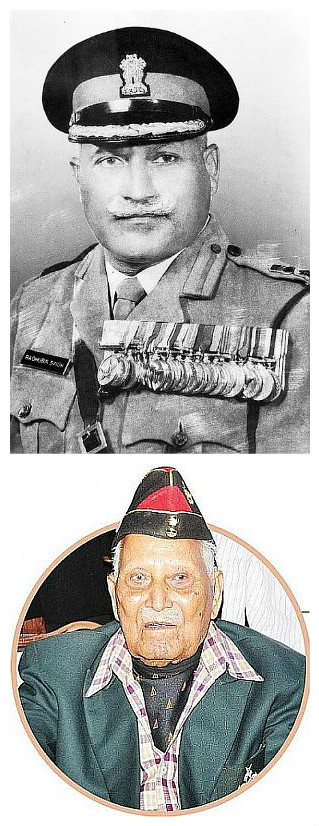
Brigadier Raghubir Singh
Courage under enemy fire
This is what the Encyclopaedia of Soldiers with the Highest Gallantry Awards, published by The Defence Review says about Col Raghubir Singh. "Lt. Col. Raghubir Singh was commanding a battalion of the Rajputana Rifles Regiment during the battle of Asal Uttar. Between 8 and 10 September 1965, the unit was attacked by Pakistani forces. On 9 September at 2100 hours, in moonlight, the enemy forces launched a ferocious attack with tanks and managed to overrun the forward company positions. Lt. Col. Raghubir Singh, anticipating the enemy's assault, left his command post and regardless of personal safety moved up to those companies past three enemy tanks. He entered the positions under intense enemy artillery fire and established contact with the company commanders. This example of courage, determination and leadership on part of the commanding officers inspired the men to defy the enemy tanks and under his command they destroyed 20 enemy tanks. "
The aforesaid really does not do a lot of justice to the act of valour and leadership shown by Raghubir Singh. Read below the details not mentioned in the citation.
In the September of 1965, then a colonel, Raghubir Singh was the last defence of Punjab, literally there were no troops after his position. If his troops were challenged and defeated, Punjab as we know it geographically would not exist. His was an infantry unit against the might of Pakistan's Patton tanks. The defensive battle of Asal Uttar was enjoined on the morning of September 8 when at about 0800 hours the tanks started to appear in the front of a forward company locality. At about 1100 hours, the tanks had appeared in front of all three forward company localities and commenced their attack.
The battalion anti-tank weapons were now employed against the tanks and with the conjunction of artillery the attack was repulsed. At about 1500 hours the tanks again appeared, formed up and fiercely attacked. This time, they made a breakthrough, the forward lines were broken. Raghubir Singh and his troops again pushed them back. On the night of 8 September enemy guns kept firing at Raghubir Singh's troops, not letting them rest.
With the first light of 9 September the enemy again attacked, luckily Raghubir Singh's team had placed some anti-tank mines in the fields the night before. But the tanks missed these mines, and were able to break the defensive lines of 18 Raj Rif. The tanks were in the midst of the Indian troops, firing at leisure, choosing their targets. Col Raghubir Singh at this juncture left his command post, pushing his troops to shoulder-on, dodging three enemy tanks which were already in our defences. He jumped into the trench to save some soldiers just as the fourth tank rolled over their head.
Tanks now were breaking into our defences with ease, men were forced to duck into their trenches as they passed them over. Some tanks would stop over the trenches and start grinding the trenches to crush the soldiers in them.
Col Raghubir Singh realised the gravity of the situation and called the artillery regiment and ordered them "DF-SOS-RED RED RED" to shell their position. Close to 100 artillery guns fired a desperate salvo on the Indian position. By now there were close to 40 enemy tanks that crossed over into Indian defences. Utter confusion prevailed, enemy tanks, Pakistani soldiers and Indian soldiers all were in a huge sand storm of dust and shrapnel caused by the insistent barrage of artillery guns.
Col Raghubir Singh maintained his cool and directed his Recoilless Anti-Tank guns to take out the tanks, simultaneously engaging the enemy with Light Machine Guns at his disposal. One by one the tanks were destroyed. The desperation changed, enemy tanks could be seen smouldering in the battle field, Pakistani soldiers lay still on the ground, and the enemy withdrew. This battle alone cost the enemy 22 Patton tanks, 19 BMG's and 3 Jeeps. The casualties from Col Raghubir Singh's regiment were 5 dead and 29 wounded, including the Colonel himself.
Unbelievable Actions
If you talk to any gallantry award winner, they invariably always say it was in the heat of the moment, the unmitigated anger at what was going on, a deep sense of what it could do to the soldiers and civilians around them, almost as if the world around them was crumbling and in response to this they did what they could to stop it. Yes, anger was the motivation but the action was not foolhardy - once the decision to take the action was arrived at, a sense of calm ensued. Of course, the decisions were logical\; they were not rushed and were unique i.e. out of the box. Nearly always, these unbelievable actions took the enemy by surprise.
In 1965, apart from many brave deeds that we are aware of, there are stories of commanders and soldiers abandoning their posts, leaving the opposing force to occupy Indian land (See Honour Redeemed and other stories from the 1965 Indo-Pak War edited by Maj Gen Dhruv C. Katoch for details).
Raghubir Singh had witnessed this and knew he was the last defence for Punjab. If he was defeated, the opposing force could reach Chandigarh in double quick time. At Asal Uttar, Raghubir Singh not only saved Punjab but also his senior officers, as they would have been given marching orders from the army after the war. In return for his gallantry, Raghubir Singh was promoted to Brigadier, bypassing some 300 other officers.
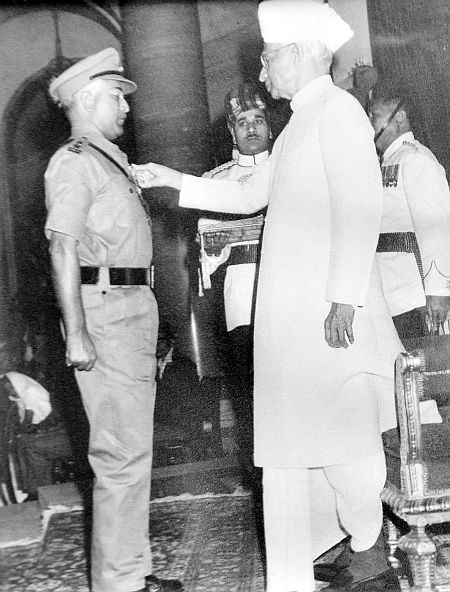
Brigadier Raghubur Singh receiving the Maha Vir Chakra medal from President Radhakrishnan.
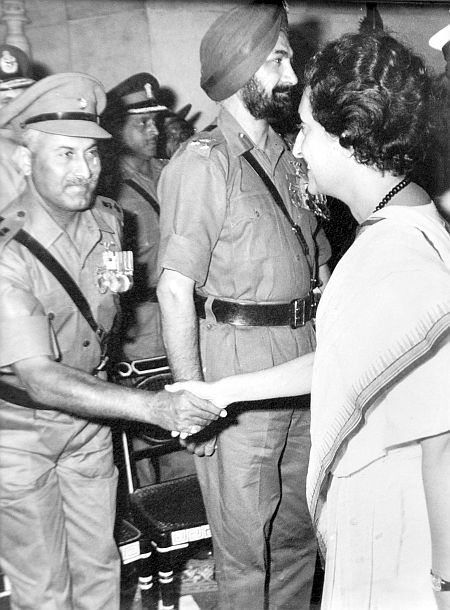
Brigadier Raghubur Singh shaking hands with Prime Minister Indira Gandhi
The making of a Braveheart
A hero is no braver than an ordinary man, but he is brave five minutes longer." Ralph Waldo Emerson
This story is not so simple, it does not have a beginning, middle or end. Brigadier Raghubir Singh's story is a tale with multiple layers and milestones, involving three principal narratives, two of which are explicit and one implied. The frame narrative of the decorated soldier Raghubir Singh - a man who made his living marking his indelible presence in layers of the past -anchors the tale in the present. Indeed, his life is the history of modern India at the turn of this century. It also invokes through the symbolic date of the battle of Asal Uttar the Indian army's magnificence during the 1965 Indo-Pak war as a fighting machine.
It is in the not so obvious narrative that I want to write about, the story of a short, intrepid man whose twinkling eyes even at the age of 95 [in 2016] forces your senses to read every movement, every twitch to understand the gladiator personality and probably imbibe some of his character. You can claim I am under influence, and, hence not honest.
Why does one get a Param Vir Chakra or Maha Vir Chakra? Is it due to military success, courage or display of superhuman resolve? More importantly, why do only a select few rise to the occasion in the face of adversity. After all, military endeavours are not Lone Ranger missions\; they are a result of collective planning and training. Why does an army that prides itself for discipline and regimentation honour individuals? Why do they sing paeans of these soldiers when they are the outliers of their system?
Conflict Zone
One ought to know the subject well to understand the real soldier in a conflict zone. Moreover, one needs to know the human in the soldier to know the veracity of his story. These are the obvious, almost dismissible "flaws" in their make-up, whose stories stupefy us. Something of this "flaw" exists in Raghubir Singh.
Do these flaws, empirical as they are, only exist in a firefight? Or do they disease the carrier for life? Did they exist in them forever and cease when they got older, wiser? There was a study done some time back to discover commonalties in character, upbringing, etc. in decorated soldiers (especially Victoria Cross) by General Sir Peter De la Billiere (Supreme Courage: Heroic stories from 150 Years of the Victoria Cross: Heroic Stories from 150 Years of the VC) to understand courage under fire to answer the question: what in hell are they made up of?
The outcome of this study is surprising. The underlining human "flaw" that is prevalent in these people is empathy\; most of them are the oldest in the family, responsible for one or more of their younger siblings.
Strong family values are the second most powerful "flaw" that exists in these soldiers. Ironically, not a single Param Vir Chakra or Maha Vir Chakra winner came from a broken family. Lastly, the understanding of legacy is more easily said than understood. Didy Grahame, Secretary of Victoria Cross and George Cross Association, said, "75% of VC and GC winners were from families where they were the oldest sibling or were the responsible child of a widowed mother. There are at least 15 families who have VC going from father to son or from brother to brother."
Martial Tradition
Does this explain the reasons why Raghubir Singh did what he did in the battle of Asal Uttar? Does it fall into a pattern? Raghubir Singh's chacha (father's younger brother) was the founder member of the fabled Sawai Man Guards. In fact, Raghubir Singh belonged to a humble village near Jaipur whose clan had a fiery relationship with the erstwhile Rajas of Jaipur -sometimes they were favourites and at other times on the wrong end of the stick. There actually exists a story where the fort of this family was razed to rubble on the orders of the ruler. These vicissitudes made this clan tough and senior families understood the value of legacy of their martial tradition. These times were different\; the clan stuck together if required to take care of their brethren, i.e. marriages, shortage of food and even employment. One had to guarantee the future of generations that were yet to be born. This was a huge responsibility that Raghubir Singh's family carried on their shoulders.
The rulers of Jaipur knew this and appreciated the bravery of this clan. Not surprisingly, the responsibility of raising the Sawai Man Guards was given to Col Ranjit Singh, Raghubir Singh's uncle, in 1934. Ranjit Singh was a decorated soldier and had been awarded the OBE (Order of British Empire).
Raghubir Singh was born in this family in 1923 and the weight of the family's legacy and its responsibility was passed on to him from the moment he opened his eyes, just because he was the eldest in his generation and hence directly responsible for his siblings. Raghubir Singh first joined the state forces in Hazari Guards and was later transferred to his uncle's regiment, the elite Sawai Man Guards.
Rajputana Rifles
After India's Independence, Sawai Man Singh Guards was amalgamated in the Indian Army and rechristened 17th Rajputana Rifles (17th Raj Rifs). It's sister regiment is the 18th Rajputana Rifles (18th Raj Rif. 18th Raj Rif is popularly known as Saurashtra as it was established with the help of the erstwhile ruler of Jamnagar, incorporating not only his own troops but troops of 20 or so other principalities.
Interestingly, 17th and 18th Raj Rif are the only two regiments of Rajputana Rifles that have maintained the original structure of having mainly Rajput soldiers in their ranks.
In 1965, the 18th Raj Rif had close to 80% men from Rajasthan, of which Raghubir Singh, a Rajput, was the commanding officer during the battle of Asal Uttar. The tradition in the army then was to enlist men from the very area where the regiment was formed or established. So, for both these regiments the enlisted men were from in and around Rajasthan. This guaranteed an esprit de corps in the regiment, a sense of belonging.
In 1965, the Indian Army was relatively small - only five to seven lakh soldiers including infantry, armoured, artillery and other services - compared to the army of today. The Border Security Force (BSF) had yet not come into existence, and hence, the army was responsible for border guard duties also. Which is why army personnel had different relationships with each other\; everyone knew each other like an old boys' network. The army of 1965 was a different army\; close relationships existed between enlisted men and their officers, as both to a large extent came from the same eographical area.
Both Raghubir Singh and his men from 18th Raj Rif came from the erstwhile Jaipur State and were close. He was fondly addressed by his enlisted men and officers as Babusa (a title given to the head of the family in Rajasthan). This explains the first and second rule of bravery under fire, i.e. empathy for the fellow soldier and Burden of Legacy.
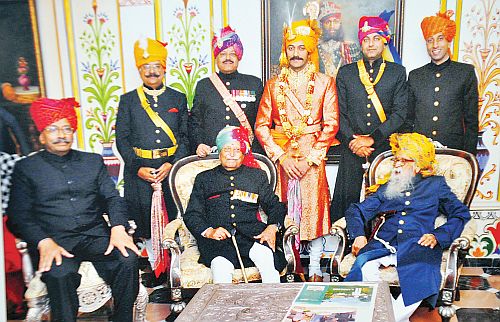
A Family Wedding, Jaipur
Seated centre: Brigadier Raghubir Singh
© Divij Sharma 2016
Comments
A fascinating and absorbing
Add new comment